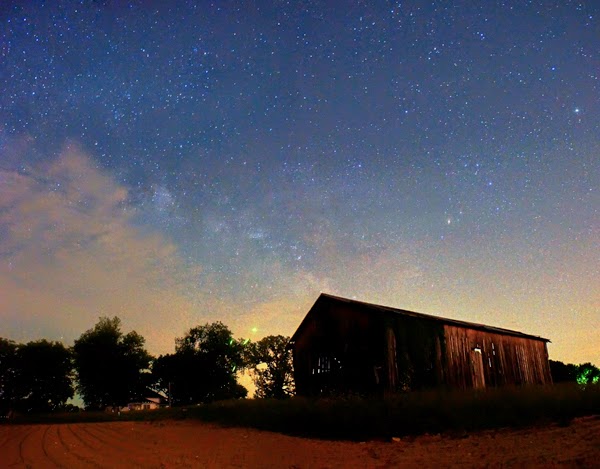Have you ever stood
under the night canopy unobstructed by trees or buildings with nothing around you, no city lights, nothing but open space as if sitting inside a giant
bubble with the night sky arched overhead?
If you live east of the Mississippi River, chances are you
have not experienced such a moment. Except for a few isolated locations, the
eastern half of the United States is more densely populated and the idea of a
dark sky is nullified by the ambient glow dome of city lights at night. Even if
you live out in the country like I do, the horizon in almost all directions is
influenced by that dome of light as it encroaches upwards and spreads above the
horizon. It may look dark to your eyes, but the light is there subtly filtering
what hovers above us. Further west there are large areas where one can still
visit the night sky almost unencumbered by this man made light pollution dome.
Many years ago I spent a year in Denver Colorado and would
commute home to Oklahoma two or three times a month. Most of the time I would
drive taking route 70 across eastern Colorado and western Kansas. During the
winter months it would get dark rather early and by the time I crossed into
Kansas the night sky was filled with stars. It was an experience I found
fascinating. During one of those drives home, the comet Hale Bopp hovered
behind my left shoulder as I drove. It was so clear and bright that the comet
acted almost like a mini moon. I even stopped once along the highway and stood
alone in the open. At the moment no other cars were insight. Just me and the
giant dome of a dark sky filled with uncountable stars, and Hale Bopp glowing
against a pure black background.
 Before then, I had
never witnessed a night in such clarity. Since then, I have rarely been able to
examine the night from such a vantage point. I now live in Kentucky which as a
location is far from being ideal for observing the night sky. Even so, on rare
occasions, the evening will blossom into a clear magical moment when the summer
Milky Way sings its melody with such clarity, the light domes along the horizon
fail to stifle its mood.
Before then, I had
never witnessed a night in such clarity. Since then, I have rarely been able to
examine the night from such a vantage point. I now live in Kentucky which as a
location is far from being ideal for observing the night sky. Even so, on rare
occasions, the evening will blossom into a clear magical moment when the summer
Milky Way sings its melody with such clarity, the light domes along the horizon
fail to stifle its mood.
Those are the evenings that make the late nights worth the
effort. Last summer I encountered such a moment and found myself standing next
to an old barn surrounded by cornfields. The evening was late, but the normal
sleepy nature I might have at that hour all but evaporated under that canopy
filled with the light of stars. The Milky Way arched high into the night and
was so bright I could just make out using just my eyes ‘The Dark Horse’ as it reared above
Sagittarius to the southwest. In that part of the sky, save for a distant
security light, the light pollution was negligible.
Even though it was
deep into the summer season, the evening was cool and delightful having been
quenched of its heat and haze by a cold front that passed through the day
before. A light windbreaker was necessary to keep the chill out.
I was able to find Andromeda and tracked it for several minutes capturing in a single image its mystical glow. What a treat it was, that evening, to share a few hours alone with sights few venture to find, and even fewer try to capture. A night under the stars, a special moment, and a unique journey involving moment and place when all the elements come together to create a revelation of time and space.
Keith





